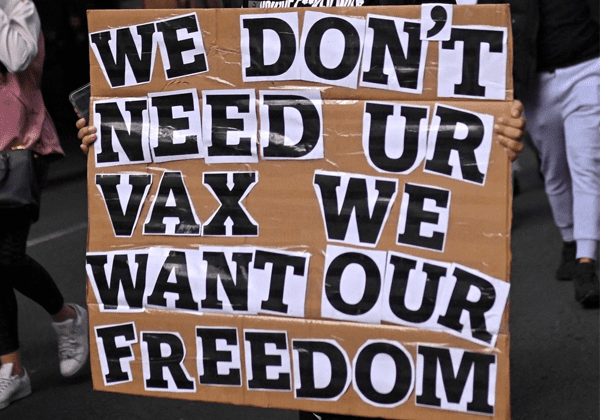‘Another figure of truth’ is an annoyingly broad conception which could be construed in many ways. Would a mere shift in the Overton window be classified as ‘another figure of truth’? Would a new articulation of a grievance that was once poorly articulated be ‘another figure of truth’? Difficult times call for difficult discussions.
And what could be a more difficult time for us all than the age we have now become accustomed to: the COVID age? As of 8 October 2021, there have been 240 million confirmed cases worldwide, with 5 million deaths. As the adage of Stalin goes, one death is a tragedy; a million deaths are a statistic. Add in the economic and mental health toll of the pandemic and you have yourself a far from ideal situation.
Now, during such pain and suffering, who could be doltish enough to protest the few weapons capable of ending the war against COVID: vaccines, masks, and lockdown? The answer: many. Melbourne and Sydney saw thousands take to the streets in defiance of lockdown and curfews, readily opposing medical advice.
Generally, anger is not a very constructive emotion. It can mobilise, no doubt, but its utility ends there. These crowds were angry, violent, and immersed in a version of truth radically different from our perception of it. While participants would claim that the protests were characterised by the pursuit of freedom and all that is in the ‘public interest’, their outcomes were violent, harmful and nothing short of dangerous.
Factor in the obvious far-right presence and the difficulties enliven to an even greater extent. The (mis)management of the pandemic is not the focus of discussion; it is now a radical, dangerous, irrational crowd that has dominated headlines. More importantly, it has led to contradictory rhetoric that is hard to reconcile.
Police presence is, all at once, criticised, spurred on and celebrated. It was not just a workers’ struggle against an oppressive state of affairs. It had no leader, saw the desecration of monuments, and was characterised by the constant reiteration of white supremacist logic. Yet, in contradiction and paradox, one can find ‘a’ truth. Not ‘the’ truth, but ‘a’ truth. A truth that is at once generous and empathetic.
What could I possibly mean? How can one be generous to a crowd that has blatantly put thousands of individuals at risk? What response other than severe condemnation could deter and address the harm done?
Generosity and empathy are not idealistic gems, born of a moral tradition and pursued in absolute terms. One inevitably risks lending legitimacy to a far-right movement that capitalizes on the pandemic, unemployment, and lockdown measures to propagate a dangerous political agenda. This agenda enforces a conspiracy theory of a pro-science, liberal elite, hellbent on destroying their version of ‘society.’ This movement must be stopped, but the pandemic has made it attractive to the disenfranchised and politically illiterate. Policing these individuals further cannot yield a positive outcome.
Opposition is an interesting affair. Revolt against orthodoxy, legitimacy and power is seductive. Policing opposition does not stifle it; on the contrary, it lends even more force to its mechanics and infrastructure. Therefore, generosity and empathy are required. When high school friends who make a living off working on construction sites find a voice in Islamophobic anti-lockdown crowds and double down on this narrative when challenged, I cannot help but feel the standard approach of policing and the reiteration of government talking points could never be useful.
When these crowds reject the science and the evidence, one must begin to draw on empathy and generosity to ask why. This question does not mean to entertain their flawed and dangerous view of the world. Instead, this question aims to ensure that such protests do not happen again.
The ‘truth’, I believe, that should be pursued from now on is that many individuals believe a narrative that will get them out of the slump they are in a slump caused by the toxic amalgamation of an unruly state of affairs: covid, lockdown, economic decline, political and scientific illiteracy, distrust of government, disinformation. To label a sizable minority of the Australian population as far-right neo-Nazis abdicates us of the responsibility to articulate legitimate grievances in a way that ensures the growing far-right movement can no longer draw on a disenfranchised working class. It also assumes that individuals are incapable of change. But even if they are not, one must always assume that individuals are capable of progress. Progress is built on the tenets of faith that our communities, which are made up of people, can be persuaded. The rhetoric of forceful anger against protestors goes against this basic grain, for their opposition and marginalisation is a source of legitimacy.
Perhaps a truth that recognises the failures of a government before and after COVID, a truth that sees protestors and their baseless views as symptoms of a difficult and existential threat, will yield the result of delegitimising the far right. The manifestation of that truth would require us to do away with our labels and anger and implore us to radically lift and invest in the welfare of the Australians who were hit hardest by the pandemic. This would require a change in our rhetoric, our solutions and economic nous.
Yet finding this truth is difficult. It would require generous engagement with a side that is not so generous. It would require disregarding the sheer damage and selfishness of protestors. But there is, in the words of Foucault, a certain pleasure that arises from doing so, since this access to another form of truth not only helps us make sense of irrationality but equips us with the capacity to prevent illegitimate manifestations of legitimate grievances. This begins with generosity.





